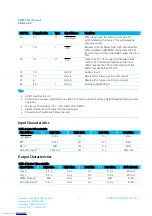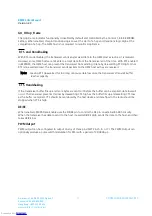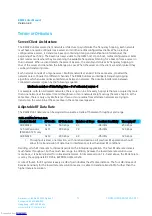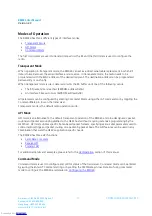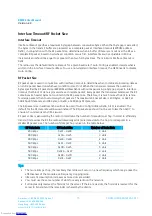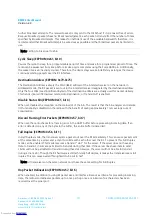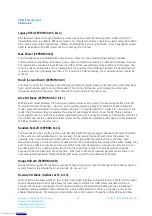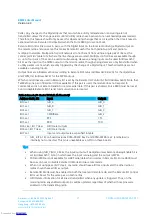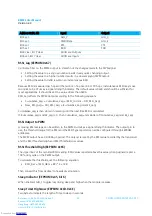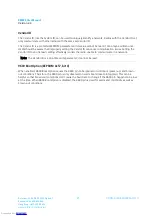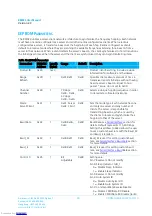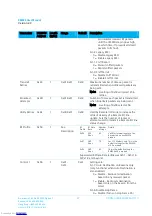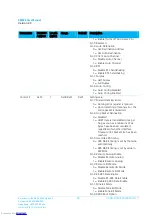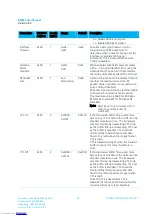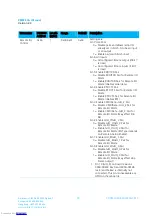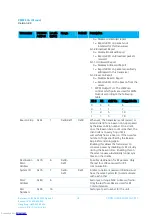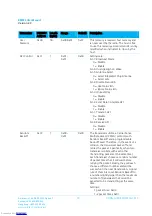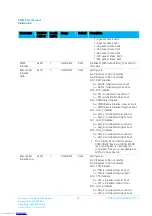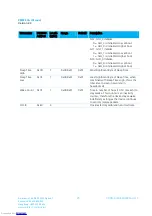
RM024 User Manual
Version 2.3
Americas: +1-800-492-2320 Option 2
Europe: +44-1628-858-940
Hong Kong: +852-2923-0610
www.lairdtech.com/wireless
20
CONN-GUIDE-RAMP24-0413
Legacy RSSI (EEPROM 0x45, bit 2)
RSSI (Received Signal Strength Indicator) is a measure of how well the receiving radio is able to hear the
transmitting radio. By default, RSSI is reported in 2’s complement format; therefore, values range from 0x80 -
0x7F. Many preceding products have, instead, reported RSSI in the range of 0x00 - 0xFF. Legacy RSSI causes
0x80 to be added to the RSSI result prior to reporting it to the host.
Max Power (EEPROM 0x63)
The transceiver has an adjustable RF output power. Power can be adjusted dynamically to optimize
communications reliability and conserve power. Each increment represents a 3 dBm 50% decrease in power.
The radios have a maximum input RF level of 0 dBm. When operated very close together at full power, the
radio’s receiver can saturate and no transmissions are possible. If the distance between the transmitter and
receiver is very short (generally less than 2 ft (.6 m) with 2.5 dBi antennas), the maximum power should be
reduced.
Mode (Server/Client) (EEPROM 0x41)
The server controls the frequency hop timing by sending out regular beacons (transparent to the transceiver
host) which contain system timing information. This timing information synchronizes the client radio
frequency hopping to the server. Each network should consist of only one server.
Nine Bit Mode (EEPROM 0x57, bit 1)
With Nine Bit mode disabled, the transceiver communicates over the asynchronous serial interface in 8-N-1
format (8 data bits, No parity, 1 stop bit). Some systems require a parity or 9
th
data bit. Enabling Nine Bit
mode causes the transceiver to communicate using 8-1-1 format (8 data bits, 1 parity bit, 1 stop bit). In this
mode, the transceiver does not validate the parity bit but simply transmits it over the RF. This is useful as
some systems use the ninth bit as an extra data bit and not just a parity bit. However, because the ninth bit is
transmitted over the RF, enabling Nine Bit mode cuts the transceiver interface buffer size by 1/9 and reduces
the RF bandwidth by the same ratio.
Random Backoff (EEPROM 0xC3)
The transceivers utilize a retry protocol with Random Backoff and a programmable back-off seed. Therefore,
in the event an acknowledgement is not received, the transceiver backs off and retries the packet. For
example, when two transceivers collide with each other (transmitting packets at the same time), each
transceiver chooses a random number of packet times that it will wait before retrying the packet. Ideally, they
each choose a different number and are successful in the next transmission. A good rule of thumb is to set
Random Backoff to a number slightly larger than the maximum number of transceivers that would be
expected to be transmitting at the same time. When set to transmit broadcast packets, where there is no
acknowledgment available, the Random Backoff value is used for all subsequent attempts.
Range Refresh (EEPROM 0x3D)
Range refresh specifies the maximum amount of time a transceiver reports In Range without having heard a
server’s beacon. It is adjustable in hop periods. Do not set to 0.
Remote I/O Mode (Address 0x57, bit 3)
Remote I/O mode allows GPIOs on two radios to be joined together so their states are reflected on the other
radio. Enabling Remote I/O mode allows the local radio to transmit its GPIO states whenever there is a
change. The states are transmitted to the radio specified by the Destination Address (or as a broadcast if
Broadcast mode is enabled). State information is only transmitted when there is a change on one of the
enabled Digital Inputs. The states are retransmitted up to the number of specified Utility Retries (Address
Downloaded from
Downloaded from
Downloaded from
Downloaded from
Downloaded from
Downloaded from
Downloaded from
Downloaded from
Downloaded from
Downloaded from
Downloaded from
Downloaded from
Downloaded from
Downloaded from
Downloaded from
Downloaded from
Downloaded from
Downloaded from
Downloaded from
Downloaded from


